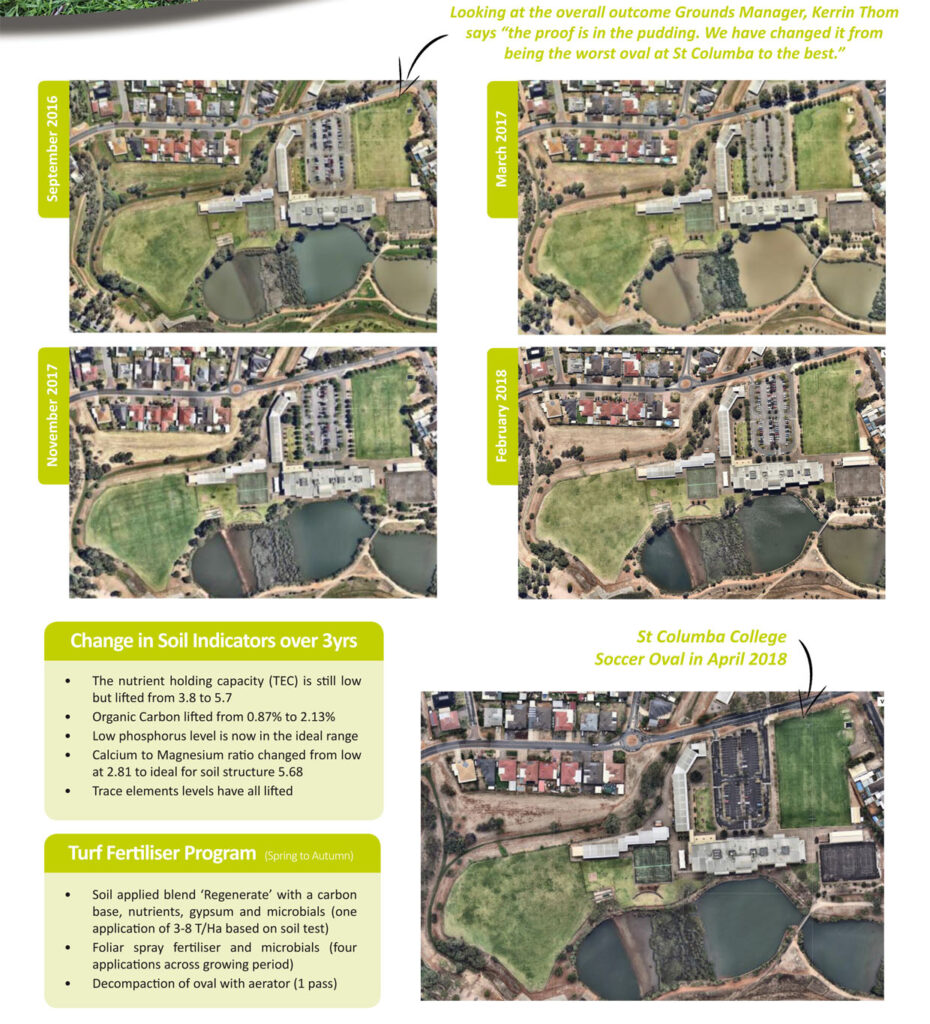
Over the past th ree years St Columba College’s Building and Grounds Manager, Kerrin Thom, has seen the schools worst oval change into its best oval. Known as the soccer oval, it has a premium location at the main entrance to the school and as well as soccer games it is a general use and play area for the students.Of the four hectares of turf at St Columba the soccer oval was most difficult to manage, the Kikuyu grass grown on sandy soil was prone to suffer from extremes in temperature or lack of water and would go into water stress straight away. ree years St Columba College’s Building and Grounds Manager, Kerrin Thom, has seen the schools worst oval change into its best oval. Known as the soccer oval, it has a premium location at the main entrance to the school and as well as soccer games it is a general use and play area for the students.Of the four hectares of turf at St Columba the soccer oval was most difficult to manage, the Kikuyu grass grown on sandy soil was prone to suffer from extremes in temperature or lack of water and would go into water stress straight away.“Over my ten years here the oval showed very little resilience, in terms of keeping good colour in stressful conditions and being a high traffic area, there were bare patches which tended to continue to recede rather than regrow. We had to keep up the fertiliser and watering as it was growing on sand with no guts in it.” Looking back to three years ago, Greene Eden’s Joel Hayes started working with Kerrin Thom on the irrigation and fertiliser program for the soccer oval;“our initial aim was to get a better result than what we were traditionally, if we saw results then we would roll it out across the other ovals. The changes we saw were a collaboration of two things; first putting in a computer-controlled irrigation management and monitoring system (Hunter IMMS) which has reduced the amount of over or under watering and has taken the manual inputs out of the irrigation control. Second was the fertiliser and turf management including addressing the lack of a healthy microbial system in the soil.”Initially the soil was analysed to establish a base line and provide custom fertiliser program, which had extra features over a traditional turf program.Joel comments “the program aimed to rebuild the soil’s microbial life whilst increasing the soils organic material content, as well as to address nutrient deficiencies and promote healthy turf growth.”Observations Looking for a quick turn-around from the changed management the initial observations were in the colour of the turf, Kerrin comments; “we saw better greenness in the grass straight away, however it is over the three years that we have seen a change in the composition of the soil. While it is still sand, it is a lot darker and we see worms under the surface.”“Another big thing we have noticed as the soil has darkened is that the grass self-generates more. Before the bare patches would recede and stay bare until we specifically treated them with fertiliser. Now the kikuyu puts out runners and many of the bare patches regrow without extra treatment.”“The oval retains its colour for longer after fertiliser applications and there is more resilience in the system. This year the oval is still holding its green into the cold months, previously by June the grass would be dormant and yellowed.” Application and MonitoringKerrin and his staff at St Columba have had support and guidance from the team at Greene Eden in making these key changes, initially with understanding the value of testing the soil and learning about the importance of a healthy microbial population in the soil.“We have relied a lot on Green Eden and have learnt to use soil tests to pick up areas of deficiency before they become an issue and be proactive with what the soil needs.”In terms of practical integration Kerrin comments; “Greene Eden are mindful of the timing of fertiliser applications around school activity and the changes have had no real impact on our other management.”The soil tests over the time show significant improvements in nutrient holding capacity, soil organic carbon, phosphorus levels, trace element levels and the calcium to magnesium ratio. |

